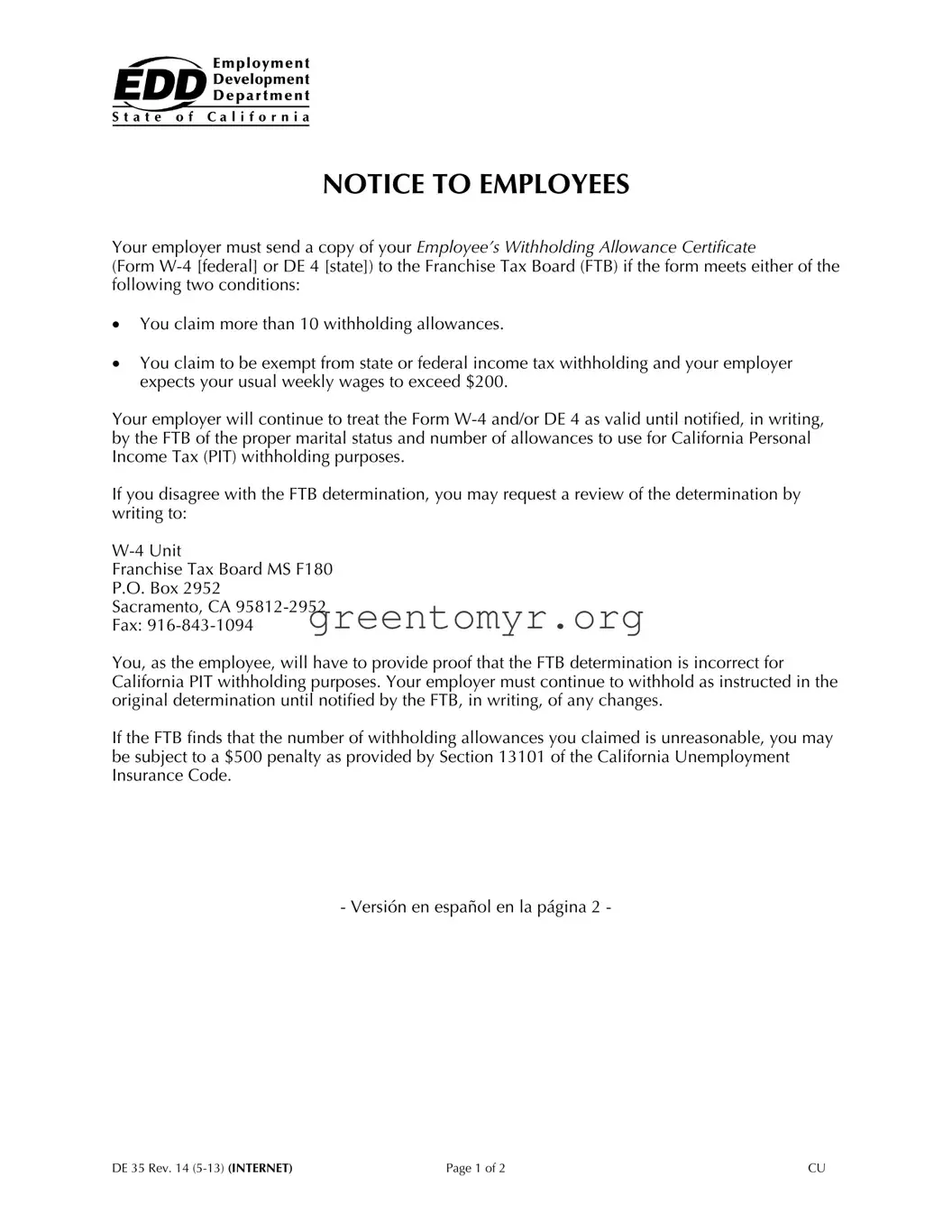NOTICE TO EMPLOYEES
Your employer must send a copy of your Employee’s Withholding Allowance Certificate
(Form W-4 [federal] or DE 4 [state]) to the Franchise Tax Board (FTB) if the form meets either of the following two conditions:
You claim more than 10 withholding allowances.
You claim to be exempt from state or federal income tax withholding and your employer expects your usual weekly wages to exceed $200.
Your employer will continue to treat the Form W-4 and/or DE 4 as valid until notified, in writing, by the FTB of the proper marital status and number of allowances to use for California Personal Income Tax (PIT) withholding purposes.
If you disagree with the FTB determination, you may request a review of the determination by writing to:
W-4 Unit
Franchise Tax Board MS F180
P.O. Box 2952
Sacramento, CA 95812-2952
Fax: 916-843-1094
You, as the employee, will have to provide proof that the FTB determination is incorrect for California PIT withholding purposes. Your employer must continue to withhold as instructed in the original determination until notified by the FTB, in writing, of any changes.
If the FTB finds that the number of withholding allowances you claimed is unreasonable, you may be subject to a $500 penalty as provided by Section 13101 of the California Unemployment Insurance Code.
- Versión en español en la página 2 -
DE 35 Rev. 14 (5-13) (INTERNET) |
Page 1 of 2 |
CU |
AVISO A EMPLEADOS
Su empleador debe de enviar una copia del certificado del empleado que autoriza la retención de impuestos conocido comúnmente en inglés como, Employee’s Withholding Allowance Certificate (Formularios W-4 [federal] ó DE 4 [estatal]) al Franchise Tax Board (la oficina de recaudación de impuestos estatales), si el formulario cumple con cualquiera de las dos condiciones siguientes:
Usted reclama más de 10 exenciones de retención en los cuales se basa la retención de impuestos.
Usted sostiene estar exento de retención de impuestos federales y estatales y su empleador espera que usted gane su salario normal semanal de más de $200.
Su empleador continuará considerando el Formulario W-4 y/o el formulario DE 4 como válido hasta que sea notificado por el Franchise Tax Board, por escrito, del estado civil apropiado y el número de exenciones que se pueden usar para el propósito de retención del Impuesto de Ingreso Personal (PIT, por sus siglas en inglés) en California.
Si usted no está de acuerdo con la determinación del Franchise Tax Board, usted puede pedir que se revise la determinación escribiendo al:
W-4 Unit
Franchise Tax Board MS F180
P.O. Box 2952
Sacramento, CA 95812-2952
Fax: 916-843-1094
Usted, como empleado, tendrá que proporcionar las pruebas de que la determinación del Franchise Tax Board es incorrecta para el propósito de retención del Impuesto de Ingreso Personal en California. Su empleador continuará la retención como fue indicado en la determinación original hasta que sea notificado por el Franchise Tax Board, por escrito, de cualquier cambio.
Si el Franchise Tax Board decide que el número de exenciones que usted reclama es irrazonable, se le podrá imponer una multa de $500 conforme la Sección 13101 del Código del Seguro de Desempleo de California.
- English version on page 1 -
DE 35 Rev. 14 (5-13) (INTERNET) |
Page 2 of 2 |


